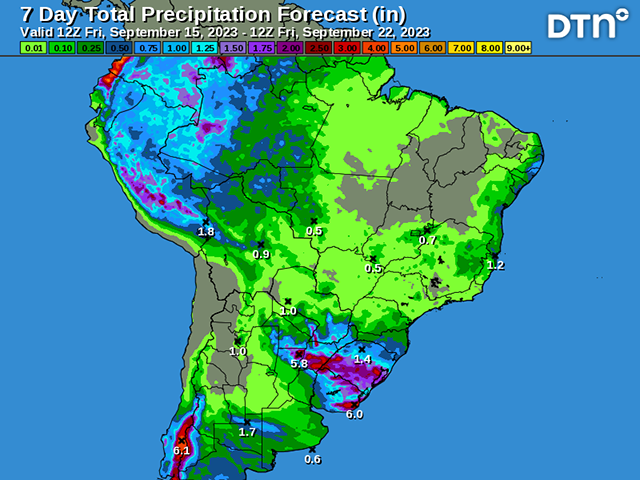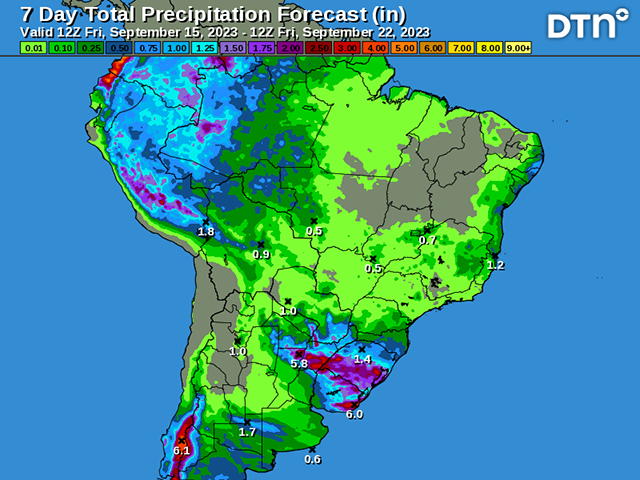Ag Weather Forum
Soybean Planting Restrictions Lifting in Brazil With Mostly Good Weather
Brazil has an incredible environment -- they can produce a double crop of soybeans and corn in the same calendar year on the same field over a vast area of the country. Without a cold winter season that would kill crops, the only limiting factor is rainfall. Brazilians start their planting season as the wet season rains come, typically in late September. The tradition is to plant soybeans first, harvest the beans in January and February, and then immediately plant second-season (safrinha) corn. Usually, as wet season rains wane in early May, the corn plants can get through pollination while the rains continue, then finish out their fill period by relying on subsoil moisture that built up during the wet season. During El Nino years, central Brazilian states like Mato Grosso and Goias can have a shortened, or inadequate wet season, which makes planting soybeans early a key goal.
The state governments in Brazil restrict soybean planting until various dates in September to limit potential impacts of soybean rust. The following is a list of when those restrictions are lifted for 2023.
| State | Soybean Planting Restrictions Lifted |
| Mato Grosso | Sept. 1 |
| Parana | Sept. 11 |
| Mato Grosso do Sul | Sept. 16 |
| Sao Paulo | Sept. 16 |
| Santa Catarina | Sept. 21 |
| Goias | Sept. 25 |
| Bahia | Oct. 1 |
| Minas Gerais | Oct. 1 |
| Rio Grande do Sul | Oct. 1 |
As of this writing, only the states of Mato Grosso and Parana can begin planting, but that will change this weekend to include the states of Mato Grosso do Sul and Sao Paulo. Together, these four states account for over 50% of Brazil's soybean production, according to USDA.
P[L1] D[0x0] M[300x250] OOP[F] ADUNIT[] T[]
Generally, these states wait for good soil moisture before planting to ensure the soybean crop does not dry up in the heat after a long dry season. That is especially true in Mato Grosso. But that state has already seen much area with more than 30 millimeters (1.2 inches) of rain over the last three weeks, and soil moisture is above normal prior to the start of the wet season, about 10 days away. The American GFS model is suggesting an on-time start to wet season rains late next week. The European model is drier through then but does continue isolated showers through this weekend to keep soil moisture adequate. Reports have not been issued just yet in the state, but planting may be getting off to an early start, especially those that can irrigate.
Heavier rain has fallen over the other three states over the winter and early this spring. These states still have some safrinha corn to pull out of the fields before they can begin planting soybeans, but that is starting to wrap up and planting has already commenced in Parana despite some wetter soils. It is likely the other two states begin planting in earnest as well.
As for the other important states in Brazil, Santa Catarina is a small state with limited production, but soils are plenty wet and ready to germinate seeds. Goias and Minas Gerais have already seen some decent rainfall over the last few weeks to encourage on-time planting, especially if the GFS is right with its on-time start to wet-season rains. Bahia has not been as lucky and while they cannot begin until Oct. 1 anyway, may end up waiting a bit to ensure the wet season is truly established first.
Rio Grande do Sul typically waits for their wheat or other small grains to be harvested before planting soybeans in a double-crop rotation. The restriction of Oct. 1 is usually early as the wheat should be maturing later this month. Their issue in that state, as noted in last week's blog here, https://www.dtnpf.com/…, is that rain has been too heavy and caused flooding issues and likely some crop damage to wheat. They will need a stretch of drier weather to get their wheat out before they can begin planting soybeans. But with a long growing season ahead and El Nino's influence of above-normal rainfall through at least January and likely longer, even a delayed planting for soybeans in this region would not be overly concerning. The same goes for their long-season corn, which is finding delays to their plantings as well.
Overall, most areas of Brazil are in good shape as restrictions lift. The weather patterns will largely favor a good soybean crop coming out of Brazil and the forecast of another year of record production seems very likely.
**
To find more weather conditions and your local forecast from DTN, head over to https://www.dtnpf.com/…
John Baranick can be reached at john.baranick@dtn.com
(c) Copyright 2023 DTN, LLC. All rights reserved.






Comments
To comment, please Log In or Join our Community .